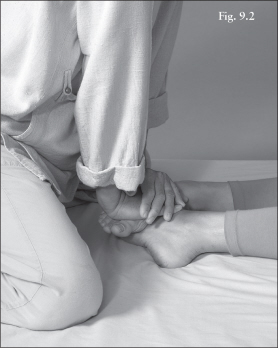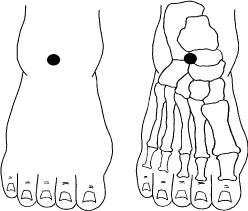
Double- and Single-Foot Postures
In the East there are many taboos surrounding the feet—where the feet can be pointed, whether they should be covered, and whose feet you are allowed to touch are all subjects of strong cultural proscriptions. In many cultures it is considered disrespectful to sit with your feet pointed at another person, and especially those who are highly revered. Yet a disciple may express devotion and love toward a guru by prostrating and touching, and sometimes even kissing, his or her feet. In certain parts of India, the earth that has been walked on by wise sages is considered purified.
Kam Thye experienced these traditions surrounding the feet firsthand while traveling in India many years ago, when he was welcomed with a cup of holy water used to wash a guru’s feet. How could he say no to such a fast-track to enlightenment?!
In the double- and single-foot postures we honor our recipients by touching their feet, a gesture of respect and regard. The first three movements here work both feet simultaneously. Once you reach Mortar and Pestle, perform all the remaining movements on one foot and then switch to the other foot.
While working on this area of the body one may encounter the occupational hazard of unwelcome odors or dirty feet. My students often ask me what would be appropriate under these circumstances. I usually give them two answers. First, I tell them to work on the client’s feet and then massage the face. Either you will lose the client, or the next time the client will return with pleasant smelling feet! Of course, this is only a joke. What I truly recommend is to always have a clean pair of socks on hand, just in case.

Foot Sandwich V↓↓ P↓↓ K↑
Sit in Open Diamond stance at the recipient’s feet and position her legs shoulder-width apart. Place your right hand on top of the recipient’s left foot. Gradually fold the foot toward the centerline, extending the sole toward the mat (fig. 9.1).
With your left hand, fold the recipient’s right instep on top of her left foot.
Place both hands on her feet, palm over palm. Gradually rock forward, applying pressure as you maintain a firm hold (fig. 9.2). Repeat three times.
Repeat on the other side.
Benefits: Stretches the peroneus muscles; stimulates digestion by working on corresponding reflexology points; alleviates fatigue in the feet and legs; relieves symptoms of arthrosis and stiff ankles.
Precaution: Avoid in cases of foot injury or knee strain; do not press the ball of one foot directly onto the top of the other foot, as this can be painful.
Vayus activated: Samana, apana
Ayurvedic tip: For vatas, take extra care to avoid bone-to-bone contact. Apply stronger pressure to break up kapha stagnation.
† Kneeing Insteps V↓↓ P↓↓ K↓
In Open Diamond stance, position the recipient’s feet shoulder-width apart. Place your palms on the recipient’s lower legs and position your left knee on the recipient’s right instep; rock forward (fig. 9.3). Apply gradual pressure as you knee up and down the instep, working on Sen Sumana. Repeat three times.
Switch knees and repeat on the other foot.
Benefits: Stretches and opens up the feet and the soleus muscles; tones the stomach, bladder, pancreas, and kidneys by working the corresponding reflexology points on the feet; alleviates fatigue in the feet and legs.
Precautions: Apply gradual knee pressure, as this massage can be intense. Distribute your body weight evenly between your hands and knees.
Vayus activated: Prana, vyana
Ayurvedic tip: All three types benefit from this exercise, as it activates movement along Sen Sumana, the main pathway for prana in the body. Apply strong pressure for kaphas.
Toe Arc V↓↓ P↓↓ K↓
Maintaining your Open Diamond stance, bring the recipient’s feet into an upright position. Place your palms on the balls of her feet and rock forward, lifting up off your heels (fig. 9.4).
Arch the toes toward the recipient’s head and maintain a steady hold. Release and repeat three times.
Benefits: Stretches the muscles on the soles of the feet; compresses the ankle joints; relieves tired legs and feet; relieves plantar fasciitis.
Precautions: Avoid this pose in cases of hyperextended knees or foot injuries.
Vayus activated: Vyana, apana
Ayurvedic tip: In this tridoshic exercise you are working on Sen Kalathari, a principal sen line that stimulates circulation and the removal of toxins.
† Mortar and Pestle V↓↓ P↓↓ K↓
From Toe Arc, center yourself in front of the recipient’s right foot, sitting in Kneeling Diamond.
Use your left hand to arc the toes, exposing the area above the ball of the foot.
Make a fist with your right hand; rock forward and use your knuckles to massage the area at the base of the toes (fig. 9.5). Work from the big toe to the little toe. Repeat twice.
Benefits: Increases blood flow to the feet; relieves plantar fasciitis.
Vayus activated: Apana, vyana
Ayurvedic tip: This massage move flushes the toxins released in Toe Arc.

Gulpha Marma
This point is located at the ankle joint, in the sensitive area just below the ankle bulge. It helps to relieve stiffness and leg fatigue. It is also a natural analgesic, or pain reliever.
Gulpha marma is stimulated during the Toe Arc.
† Shoe Polish V↓↓ P↓↓ K↓
From Mortar and Pestle, firmly hold the recipient’s sole with your right hand.
Using the fingertips of your left hand, massage the top of her foot in a circular, spiraling motion. With a light whirlpool rock, work from the arch to the toes (fig. 9.6). Repeat five times.
Benefits: Increases circulation and lymphatic stimulation on the dorsal side of the foot.
Vayus activated: Apana, vyana
Ayurvedic tip: Your vata recipients will especially love this soothing, calming foot rub. Your kapha recipients may love it too much!
† Toe Dance V↓↓ P↓↓ K↓
From Shoe Polish, grasp the recipient’s big toe by creating a clamp with your thumb, index finger, and middle finger.
Swirl the toe around, as though the toe is a delicate spoon with which you are stirring honey into hot tea (fig. 9.7). Complete three circles and then repeat in the other direction. Continue to work on all five toes in the same manner.
If you are giving an extended Thai Yoga Massage, return to the Mortar and Pestle and perform all the single-foot postures on the other foot. To end the foot exercises, caress all parts of the recipient’s foot.
Benefits: Promotes circulation to the feet and toes; wakes up the toes.
Vayus activated: Apana, vyana
Ayurvedic tip: This a playful technique that can be especially good for dispersing pitta’s intensity. Have fun with this swirling dance!
Transitional Flow
Move to the recipient’s right side and take position in the Open Diamond stance. This is the end of the foot exercises.
We’re now ready to move on to sen work on the legs and the single-leg postures.